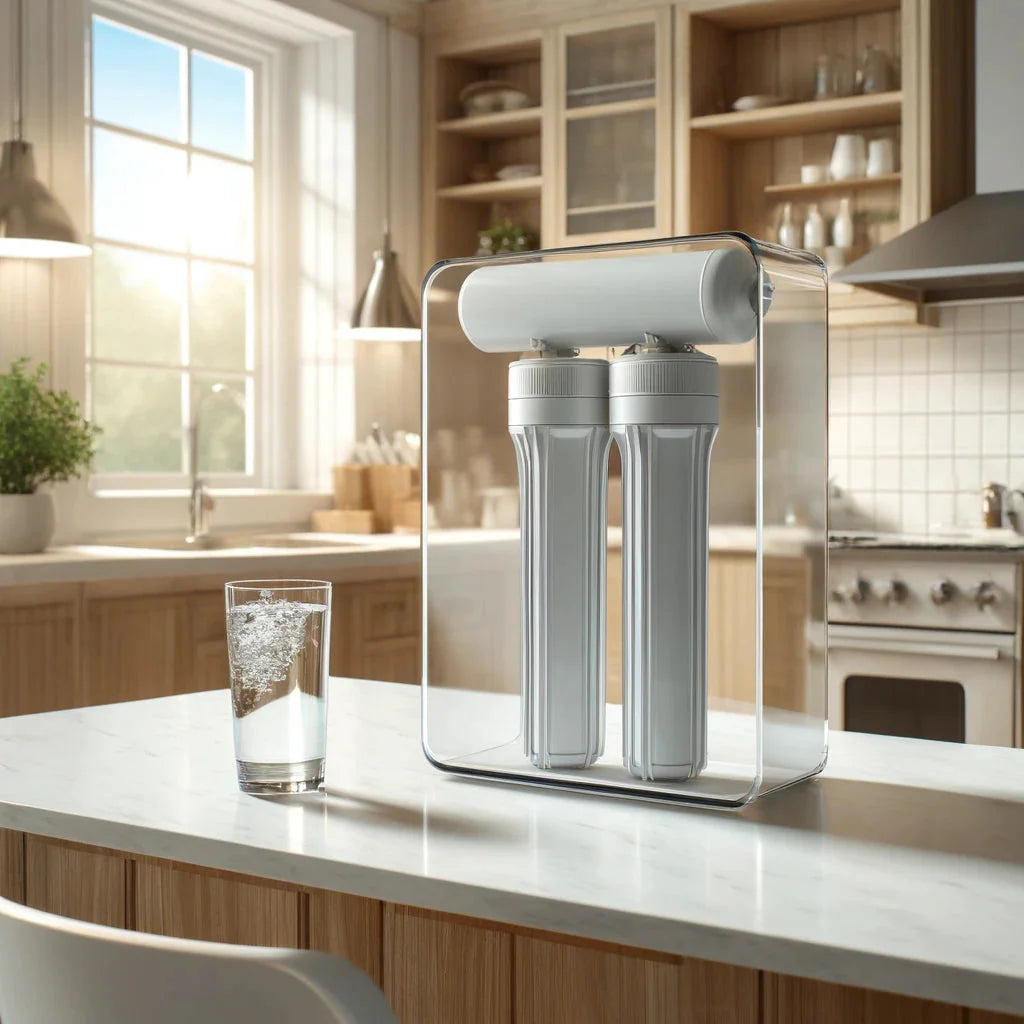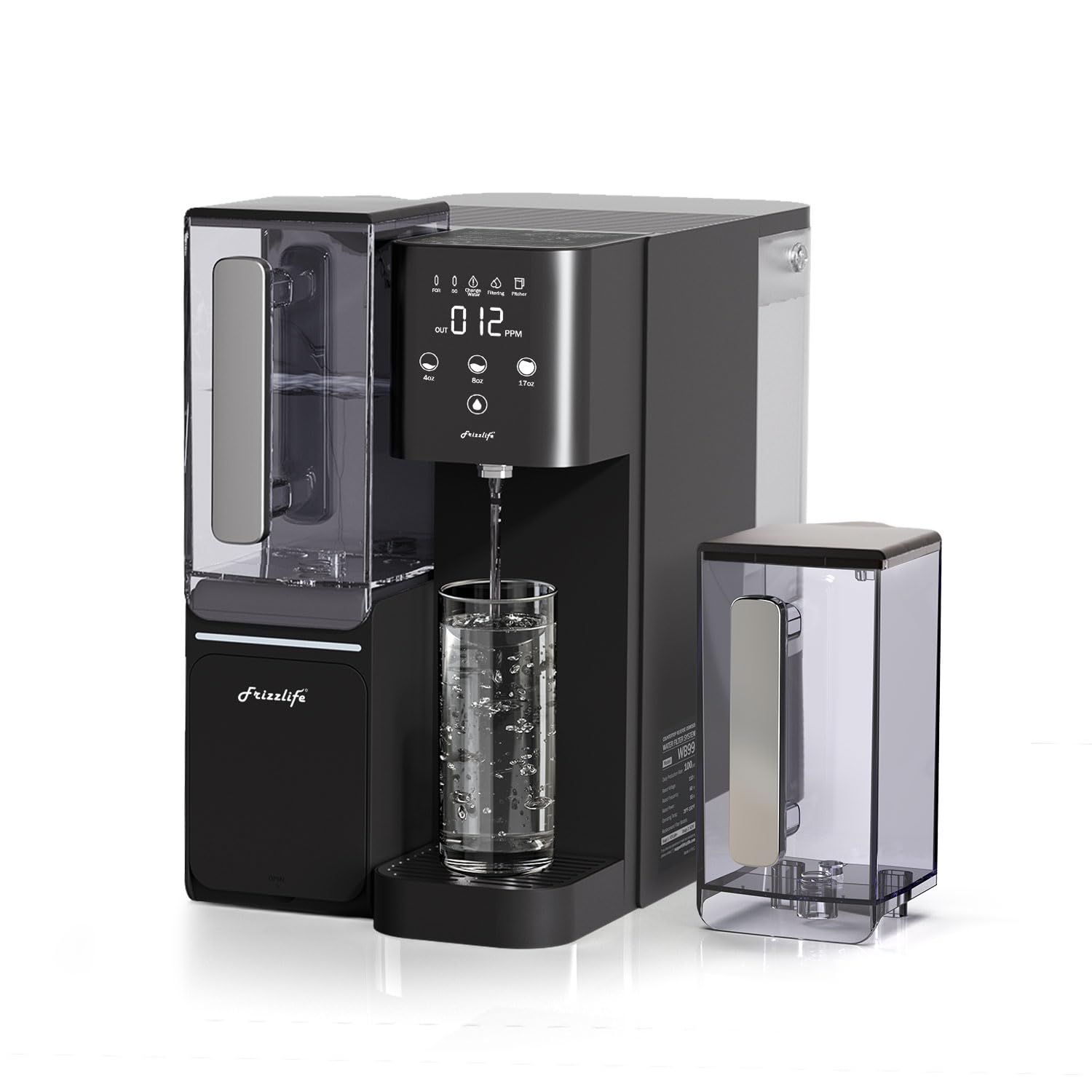
Pure Water at Home: The Ultimate Guide to Countertop Reverse Osmosis Filters
|
|
Time to read 10 min
|
|
Time to read 10 min
Water is essential for life, and the quality of the water we consume directly affects our health and well-being. Among the various water filtration methods available, reverse osmosis (RO) systems stand out for their ability to remove a broad range of contaminants, including dissolved salts, bacteria, and other impurities.
These systems push water through a semipermeable membrane, leaving contaminants behind and delivering clean, purified water.
Countertop reverse osmosis water filters are particularly appealing due to their portability, ease of installation, and capability to provide high-quality drinking water without the need for under-sink plumbing. They are an excellent choice for renters or those with limited space who still want the benefits of reverse osmosis filtration.
Furthermore, countertop models are often designed with user-friendliness in mind, making maintenance and filter changes straightforward tasks.
When shopping for a countertop reverse osmosis water filter, there are several critical factors to consider. The filtration effectiveness, which often describes the number of stages in the purification process, is paramount.
Additionally, the system's water production rate, waste-to-pure water ratio, and the longevity of the filters are crucial aspects that can affect overall satisfaction and operating cost.
Before presenting our curated selection of reverse osmosis countertop water filters, we thoroughly researched and tested a broad range of systems. Our focus was on efficiency, ease of installation, water quality, and system design to ensure that we only recommend products that meet our high standards for performance and value.
Whether you're looking to improve the taste of your drinking water, reduce contaminants, or seek a convenient water filtration solution, our top picks are designed to deliver on all fronts. They transform your water into a cleaner, healthier beverage with every pour.
We believe the Bluevua RO100ROPOT is a solid choice for those seeking a countertop reverse osmosis filter due to convenience and efficiency.
Pros
Cons
Using the Bluevua countertop water filter has changed our view on tap water. Just plug it in, and in moments, it begins transforming questionable tap water into something that we now consume with confidence.
The sleek, modern design seems right at home in our kitchen, and there's this undeniable convenience in watching the glass carafe fill up with pure water – it's almost like a visual guarantee of purity.
Admittedly, as compact technology goes, this one's a bit of a countertop hog. Space in a kitchen is premium, and dedicating a chunk of that real estate to a water filter is something of a commitment. For us, cleaner water is worth the trade-off, but that may not be the case in a studio apartment or a cluttered kitchen.
Then, there's the matter of sustainability. While we appreciate not generating plastic waste with bottled water, it's disconcerting to know some of the water processed by the system isn't utilized. Here in California, where every drop counts, we're mindful of the excess.
Moreover, watching the filter life indicator is somewhat of a double-edged sword; it's helpful, yet also a reminder of the maintenance costs down the line.
We believe this system is a smart choice for those who want pure drinking water without the hassle of installation or a fixed water source.
Pros
Cons
Upon integrating the SimPure Y7P into our space, the ease of use was immediately apparent. It's been a breeze to get pure, safe drinking water – just plug it in, and it's ready to go. The absence of installation steps is a significant time-saver.
Tasting the water, I noticed a remarkable difference. It's crisper, with a level of purity that bottled water simply can't match. The UV purification system does its job silently but effectively, reassuring me of its sterility with every sip.
Considering sustainability, this RO system stands out. We've been contributing less to plastic waste, which is always a win. Additionally, the efficiency in water usage compared to other models means we're saving water, which is both environmentally and economically beneficial.
We believe the Stokk T1 UV RO System is a robust choice for anyone seeking to elevate their drinking water quality with ease and efficiency.
Pros
Cons
Having freshly filtered water on demand has never felt so simple. The Stokk T1, with its 6-stage RO system, not only strips away contaminants effectively but also reintroduces vital minerals. We noticed a distinct difference in the taste,—crisp and refreshing.
We appreciate the plug and play aspect. Straight out of the box, the Stokk T1 set itself apart from under-sink installations. It's portable and can be placed wherever we find convenient, from the kitchen countertop to the office space.
Monitoring the system's status is as painless as glancing at the built-in TDS display. It keeps us informed about the water quality and nudges us when it’s time for a filter change. This level of interaction instills confidence in the water we drink daily.
Our experience shows that the Frizzlife Countertop RO System is a solid choice for those seeking purified water with ease.
Pros
Cons
Anyone looking for a countertop reverse osmosis water filter will appreciate how the Frizzlife system employs a simple plug-and-play approach. No fussing with tools or plumbing – we were up and running in no time.
The daily convenience of pure, clean water at our fingertips felt like a noticeable upgrade to our hydration habits.
The dual-pitcher design struck us as particularly thoughtful, enabling us to keep one in the fridge for chilled water while the other stayed accessible on the counter. Plus, the digital panel eliminated any second-guessing about TDS levels or filter life, factoring heavily into the feeling of reliability and control over the water we drink.
While we embraced the benefits, we did notice that the pitcher isn't entirely leak-proof and the flow rate doesn't match a traditional faucet's sprint. Despite these minor downsides, the positives far outweigh the negatives, cementing the Frizzlife Countertop RO System as a mainstay in our daily routine. The ample tank capacity caters perfectly to our family's needs, ensuring a constant supply of high-quality water.
We believe the Aqua Ionizer Deluxe 7.0 is a sound investment for those who prioritize water purity and health benefits.
Pros
Cons
Having used the Aqua Ionizer Deluxe 7.0, we've noticed the water tastes fresher and feels softer. The multiple settings allow us to adjust the pH level based on our needs, which is ideal for drinking, cooking, or cleansing.
The self-cleaning feature is also a plus, indicating high marks for maintenance ease.
Admittedly, there has been a learning curve. Figuring out the best pH levels for different uses required some trial and error. However, the large LCD provides clear guidance, adding to the user-friendly experience.
With the machine's longevity and a limited lifetime warranty, our confidence in the product has only grown. While it's a more noticeable addition to our countertop space, its sleek design doesn't intrude on the kitchen aesthetic.
We find the Bluevua RO100ROPOT-LITE to be a convenient choice for pure water without the fuss of installation.
Pros
Cons
Having recently put the Bluevua RO100ROPOT-LITE to the test, we can speak to its ease of use right out of the box. It's refreshing not to deal with complicated installations; just plug it in and experience the clarity of purified water.
The smart LED caught our eyes, making it a breeze to keep track of filter life and water volume selections.
Our experience with the speed of this system was noteworthy. Waiting less than three minutes for a refreshing glass of water strikes us as efficient. We also enjoyed the bonus of being eco-friendlier, given the 3:1 filtered-to-waste water ratio, setting it apart from less efficient filters we've encountered.
Although the cost is on the higher side, we view it as an investment in convenience and quality. For individuals or couples, its capacity is ample, but those with greater needs may find it limiting. Be mindful that access to a power outlet is mandatory to operate this countertop marvel.
Considering its robust design and exceptional purification performance, we think the APEC ROES-50 is a wise investment for those who value purity and taste in their drinking water.
Pros
Cons
Having the APEC ROES-50 Essence Series water filter system at our disposal meant saying goodbye to the days of worrying about contaminants in our drinking water. We noticed a significant improvement in water taste, which made beverages and cooked dishes more enjoyable.
The assurance of having water purified through a 5-stage process, verified by a WQA certification, allows us to drink confidently, knowing we're consuming water that is virtually free from harmful substances.
The installation of the ROES-50 system was straightforward, thanks to the clear instructions provided. Although it took up some space under our sink, the sleek design and quiet operation of the system meant that it was neither seen nor heard. It simply did its job, providing us with clean water without the hassle.
However, we quickly realized that having such a sophisticated water filtration system comes with responsibilities. Regular filter changes are essential, although not too burdensome, as it ensures the longevity and efficiency of the system. The initial setup costs might deter some, but when we considered the amount we would save on bottled water and the expected longevity of the system, it felt justified.
When choosing a reverse osmosis water filter for the countertop, we should consider several essential features:
Filtration Stages: Look at the number of stages the system uses. More stages can mean more thorough filtration, typically ranging from 4 to 7 stages.
Water Pressure: The optimal operating water pressure is crucial for efficiency. Ensure that the system can function well with your home's water pressure.
Daily Production Rate: Assess the gallons per day (GPD) rate to ensure it meets our daily water usage needs.
Size and Space: Since countertop models should fit in our kitchen space, measure the available area to ensure a proper fit.
Ease of Installation and Maintenance: We prefer systems that are straightforward to install and with filters that are simple to replace.
Cost of Replacement Filters: Consider the long-term cost of ownership, as we'll need to replace filters periodically.
Features to Compare
Why It's Important
| Filtration Stages | Determines the purity level of the water |
| Water Pressure Compatibility | Ensures system efficiency and proper functioning |
| Daily Production Rate | Must align with our daily water needs |
| Dimensions | To fit within our designated countertop space |
| Installation & Maintenance | For ease of use and system longevity |
| Filter Replacement Cost | Impacts long-term affordability |
In this section, we aim to address common inquiries about countertop reverse osmosis water filters and provide clear, factual responses.
Countertop reverse osmosis filters offer convenience and portability, allowing us to have purified water without the need for complex plumbing. They are easy to install and can be an effective solution for spaces where under-sink systems would not fit.
Countertop models require less installation effort and are visible, while under-sink systems are hidden and may offer a higher filtration capacity. Each has distinct space requirements and aesthetic implications for the kitchen environment.
These systems are designed to reduce a wide range of contaminants, including lead, chlorine, fluoride, and various bacteria and viruses, ensuring the water is safe for consumption.
Yes, certain models come with remineralization filters that add beneficial minerals back into the water after the reverse osmosis process, which can improve taste and balance pH levels.
Maintenance typically involves filter replacement according to the manufacturer's schedule, which is crucial to maintain the system's effectiveness at removing impurities and preserving water quality.
Consider your water usage and available space. Also, think about your specific contaminant removal needs. Lastly, decide if you prefer a system with additional features, such as UV purification or remineralization, to meet the unique needs of your household.






